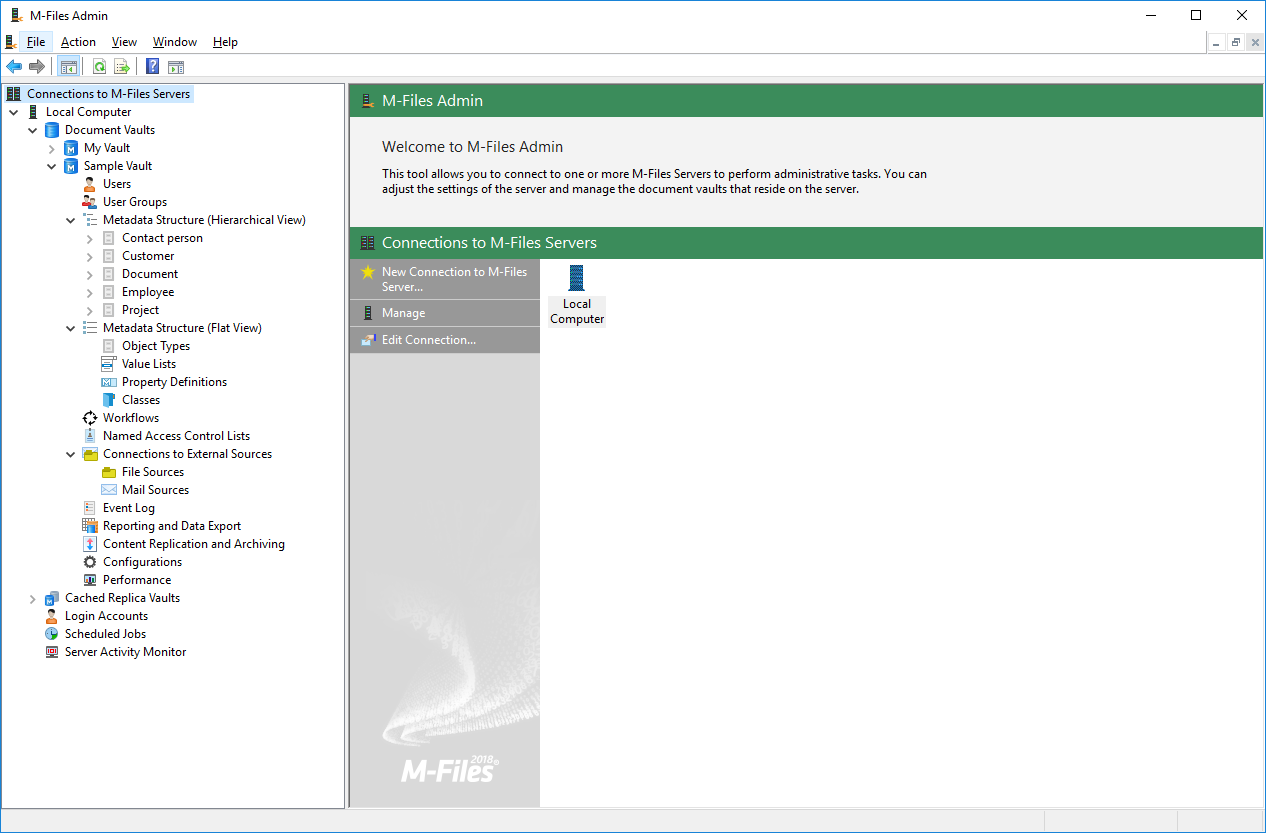M-Files Admin
M-Files Admin is a tool that is used for administrating and maintaining M-Files document vaults and M-Files Server connections.
M-Files Server is the backbone of the M-Files system. It saves all objects (such as documents, employees and customers), controls access rights, registers object modifications (version history), and allows the system administrator to configure connections also to other systems (such as a customer registry). Basically, M-Files Server saves and controls all information related to the M-Files system.
Technically, M-Files Server, like M-Files Desktop, is a service. This means that M-Files Server starts automatically when the server computer starts. The M-Files Server software is run even if there are no users logged in on the computer running the M-Files Server software.

The M-Files Admin main window displaying the different levels inside a document vault.
M-Files Admin Terminology
|
Login account |
The M-Files Server login account that is used to log in to M-Files Server and on the basis of which a new user can be added to the document vault. |
|
Metadata |
In M-Files Admin, you can change the structures of metadata (for example, value lists, property definitions, document classes, and document class groups) and create new metadata, whereas you just specify values for these metadata items in the day-to-day use of M-Files. Compare with M-Files Terminology. |
|
Object type |
Besides documents, you can also manage other objects, such as customers and projects. These data set definitions are called object types. Document is one object type. |
|
Property Definition |
Property definitions are used to determine properties associated with document classes. A property definition is used to define the property name (which should be descriptive) and data type, which determines the type of the data entered (in relation to the property). |
|
Role |
Roles can be used to provide users with permissions that mainly affect M-Files Server Administration. The permissions gained through roles always take precedence over document and object permissions. User who has all permissions to a document vault can access any object, even if the access of a particular user to a document has been denied by means of object-specific permissions. |
|
System administrator |
A system administrator is a user who has been assigned the role of system administrator. This means that the user's login account has the server role System administrator. With this role, the user gets all the permissions to each vault on the server and the user has server-level access to do all possible functions in M-Files. A system administrator can add the role of system administrator to other login accounts. For a system administrator to log in to a vault on the server, a user account in that vault is not necessary. |
|
User |
The M-Files user, who, at the server level, can be either a regular user or a system administrator. Users can be added to the desired document vaults, and a user's document vault administration permissions depend on the document-vault-level roles assigned to the user. On the document vault level, roles mainly determine the user's permissions to document vault administration. A regular user's basic permissions are also assigned by means of roles. Users can be grouped into external and internal users. For example, you can define your customers as external users. External users can only see and access documents and objects specifically marked for them. By default, they do not have permissions to view any documents. |
|
User group |
You can create user groups on the M-Files server to which individual users can be added. Each user automatically belongs to the user group All internal and external users. In addition, each internal user automatically belongs to user group All internal users. User groups are specified on the document vault level. User groups can be used to define the permissions to an object, that is, to specify the users who may access it. |
|
Value List |
A value list is a list that contains various values, such as the names of all customers. The same value list can be utilized in several different properties. |
|
Vault |
The document vault is managed with M-Files Admin. This is where you can add users to the document vault, change the metadata structures of objects, and edit views visible to all users. See also M-Files Terminology. |
|
Workflow |
Workflows define how the organization manages a process. An example of a workflow is invoice circulation. The workflow has related states and definitions regarding the task performer, permissions, and state transitions. |
